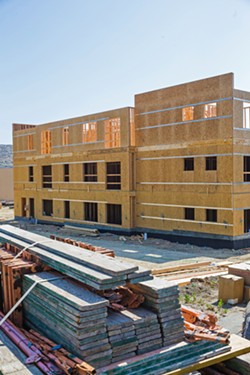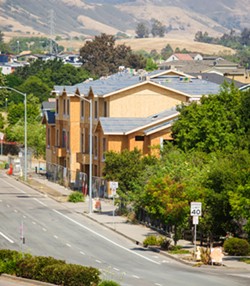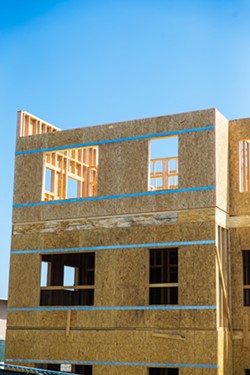When COVID-19 struck, Coastal Community Builders had just sent out a newsletter to thousands of prospective homebuyers.
After years of planning, the Pismo Beach-based development company had finally broken ground on San Luis Ranch, a 580-home community on the former Dalidio Ranch in San Luis Obispo. A March project newsletter gave an optimistic progress report to its 3,000-member waitlist.
"We reached out to everybody and gave them a little bit of a better idea about what products would be there, keeping them engaged," said Gary Grossman, president of Coastal Community Builders. "Right after that, COVID hit."
Like in every industry, COVID-19's onset and the stay-at-home orders brought anxiety and uncertainty to the construction and building trades. Designers and developers, construction workers, bankers, brokers, investors, and government officials all wondered how the pandemic would impact their projects and bottom lines.
Grossman, who has five active housing projects on the Central Coast, from Templeton to Orcutt, told New Times that he and his peers "took a big gulp" in March as the economy appeared to start unraveling. The idea of halting their active construction projects for months on end seemed untenable.
"We were just sort of like, 'OK, how are we going to handle this?'" he said.
More broadly, industry stakeholders worried about how a sudden recession could derail years of progress toward creating a fertile building environment in California—especially for building housing amid a statewide shortage.
"There's a great opportunity right now. We've got a governor who wants housing in California," said John Fowler, CEO of Peoples' Self-Help Housing, which has affordable housing projects under construction in Santa Maria and Guadalupe. "We don't want to slow up because of a pandemic, because things are lining up, both politically and financially. It's a good time to produce housing at all levels."
At least in the short term, the gears of construction didn't grind to a halt. They barely even slowed down. Under Gov. Gavin Newsom's March 19 shelter-at-home order, construction was deemed an essential service and allowed to continue. While many counties chose to regulate and restrict some construction activities in local shelter orders, SLO and Santa Barbara counties opted for a relatively hands-off approach.
Local builders and government officials said projects on the Central Coast moved forward despite the pandemic—boosted by the political will to produce housing and help stabilize a crippled economy.
"Everybody's pretty bullish, pretty enthusiastic," Grossman said. "I think you'll see that most of the projects kept going. All of our projects did. We kept moving on."
Staying at work, safely
Grossman wasn't exactly surprised that the COVID-19 orders, which impacted so many sectors of the economy, exempted construction activities.
"If you think about how much [construction] there is between commercial, apartments, residential, ... if it was all halted, that's some $30 trillion in bank loans," Grossman said. "It would've been hard on the banks, hard on all of the industries. And we employ a lot of people."

- Photos By Jayson Mellom
- BUILDING SUPPLIES While COVID-19 halted much of the economy, the state deemed construction an essential activity, and it's largely continued on the Central Coast.
From the company executives to the construction workers, industry members said that they were glad to continue working. Construction crews adopted new safety measures to protect against the virus, including social distancing and sanitizing.
Those measures have largely proven effective in staving off COVID-19 infections at work sites, according to Tony Skinner, an executive officer at the Tri-Counties Building & Construction Trade Council, which represents 33 craft unions in SLO, Santa Barbara, and Ventura counties. Even so, some workers opted to stay home and not put themselves or vulnerable family members at risk.
"There's a couple of people who [contracted COVID-19], but for the amount of people [out] there, that's not bad," Skinner said. "The national building trades came out when this first hit and put out safety standards for jobs, and it seemed to work."
Skinner said that the local building trades have been "very fortunate" to not see a slowdown in work during the pandemic. He said construction in the region "is as strong as it's been."
"It could've hit us a lot harder than it did," Skinner said. "There's been very, very little ripple effect. A couple of jobs were delayed, but they're still on the books."
That forward momentum is not just evident in the for-profit building sector. Fowler, of Peoples' Self-Help Housing, said his affordable housing nonprofit has "been building all through the pandemic."
"Our subcontractors really wanted to work, and we really wanted them to work," he said. "We're right on schedule."
Fowler said that both a 40-unit affordable senior housing complex in Santa Maria (called the Sierra Madre Cottages) and a 38-unit farmworker housing project in Guadalupe (Guadalupe Court) are on track for grand openings in July and August, respectively.
In addition to approaching the finish line on those projects, Peoples' Self-Help Housing has also continued with its "self-help home building" program during COVID-19. In April, 10 low-income families in San Miguel finished construction on their own houses, which effectively reduced their final cost.
"The families continued to build, finished their homes, and moved in during the pandemic," Fowler said.
The nonprofit also acquired new property since March and continues to provide its other housing services remotely.
"Everything from acquisition to construction, design, approval, and moving people in—all facets of housing are moving forward," Fowler said. "For us, it's been full-steam ahead."
Strong fundamentals
As SLO Community Development Director Michael Codron closed up shop at City Hall in March due to COVID-19 precautions, he and others in city leadership remained focused on how to keep the momentum of a historic year going.
The 2019-20 fiscal year was a record-breaker in SLO in terms of development and building activity, and city officials wanted to continue to accommodate that surge remotely if it continued.

- Photos By Jayson Mellom
- HOUSING SUPPLY Housing remains a priority in San Luis Obispo, and this project, The Junction, next to Miner's Ace Hardware, will bring 69 residential units and 3,000 square feet of commercial space to the city.
"We had to sort of reinvent how we do business," Codron said. "We actually already had plans in place to accept online applications, but that wasn't going to happen until the end of 2020. Under the circumstances, we were able to expedite that."
While other city revenue streams took huge hits during the COVID-19 shutdown, planning and building fees remained relatively steady; the city continued to issue building permits and accept new planning applications online at a surprising pace. Despite the many impacts of the pandemic, the department wound up exceeding its 2019-20 revenue projections by about 20 percent—a testament to the building atmosphere in town.
"I do think it's a good sign," Codron said. "As investors and financiers are looking for a safe place to put their money, I think when you see large construction projects continue to move forward and even new applications come in, it's a good sign that the fundamentals of the economy are still strong and that we have the potential to continue to accomplish a lot of our goals as it relates to building out the city and our current focus on more housing."
A quick glance at an online map of active construction projects in SLO shows that strength. Housing and mixed-use developments speckle the map. Fowler noted that the push for housing, both locally and across the state, is acting as a strong tailwind for these projects.
"We're so underproduced at this point. We've fallen way behind on all of our housing," Fowler said. "There's a pent-up demand if we can produce it."
Private developers also spoke to promising signs of stability in the economy. Even amid extreme economic uncertainty, Grossman of Coastal Community Builders said banks continue to lend and homes continue to sell—albeit under revised circumstances and expectations.
"We all wanted to know that the lending institutions would be working as they should," Grossman said. "And I'm happy to say, I've been impressed. Everybody's going to be a little more conservative and a little more careful because we're in territory we haven't seen before, but our lending partners have been very with the spirit of what everybody's been hoping for."
Pat Arnold, CEO of Covelop in SLO and president of the Downtown SLO association, also praised the work of the banks, particularly the regional banks, during the crisis.
"They've been amazing to work with," Arnold said. "They get it; we're mid-project, we can't stop. There's no way to stop without it failing."
Confidence, concerns, and the future
While COVID-19 hasn't stopped most active construction projects from moving forward, it has impacted new plans for development. And its long-term effects remain to be seen.
Arnold said that investor confidence is low for newer projects in their early planning stages. He recently applied for a U.S. Small Business Administration loan to avoid furloughing employees on his design and development team.

- Photos By Jayson Mellom
- CONSTRUCTION MUST GO ON Anxious about their investments when COVID-19 hit, developers have been relatively unaffected by the pandemic due to stay-at-home orders exempting construction activities. Twin Creeks, a mixed-use project in San Luis Obispo with 94 units of housing, remains under construction on Orcutt Road.
"Our development side got extremely quiet due to investor confidence," he said. "Short-term access to capital and investors is just down right now."
Fowler with Peoples' Self-Help Housing noted that a decline in investor confidence could impact the viability of future affordable housing projects on the Central Coast.
"Where I think we're going to have some issues is investors. There's a bit of a hiccup in the financing world," Fowler said. "Banks are the ones that invest in affordable housing. They put the equity in for us."
That uncertainty bleeds over from the private world to the public realm at cities, school districts, and counties. As tax revenues slump across the board, fewer dollars will be available to pay for public construction projects—from simple road maintenance, to new classrooms, to Fowler's specialty: affordable housing. That's an ongoing concern for government leaders, development professionals, and construction unions, whose members are often hired to work on those projects.
"[Public] funding is always something that we're looking for," said Skinner, of the Tri-Counties Building & Construction Council. "Who knows what's going to happen with the cities and counties once budget time comes?"
Projected tax revenue shortfalls are partially why U.S. Rep. Salud Carbajal (D-Santa Barbara) and regional officials are advocating that Congress earmark more federal economic relief funds for local infrastructure projects. In Santa Barbara County, officials claim $700 million worth of road and highway projects are shovel-ready and could happen quickly if they were fully funded. Local representatives want to see the second federal stimulus bill include an allocation for these types of county-level projects.
"The idea is that would be an infusion of funds to get the economy going again. We estimate that $700 million would stimulate 9,000 jobs," said Marjie Kirn, executive director of the Santa Barbara County Association of Governments.
As COVID-19 continues to reshape society, building industry members said it will also inevitably reshape the future of development. Given the pandemic's impact on retail, restaurants, and office spaces, investors and developers may find commercial projects less attractive in the future.
"It will look different," Arnold with Covelop said. "We'll have more home offices than we ever thought we'd have."
One building sector that industry members don't see slowing down is housing. The clamor for more housing in California will keep all sectors of the building industry busy for a long time, they said.
"There's an undeniable housing shortage in California, and that shortage isn't going away," Grossman said. "We've been operating on a shortage of housing for a long time. I think that as lending institutions and our markets are looking at it, they're saying one way or another, we're going to come right back to the same thing." Δ
Contact Assistant Editor Peter Johnson at [email protected].

Comments